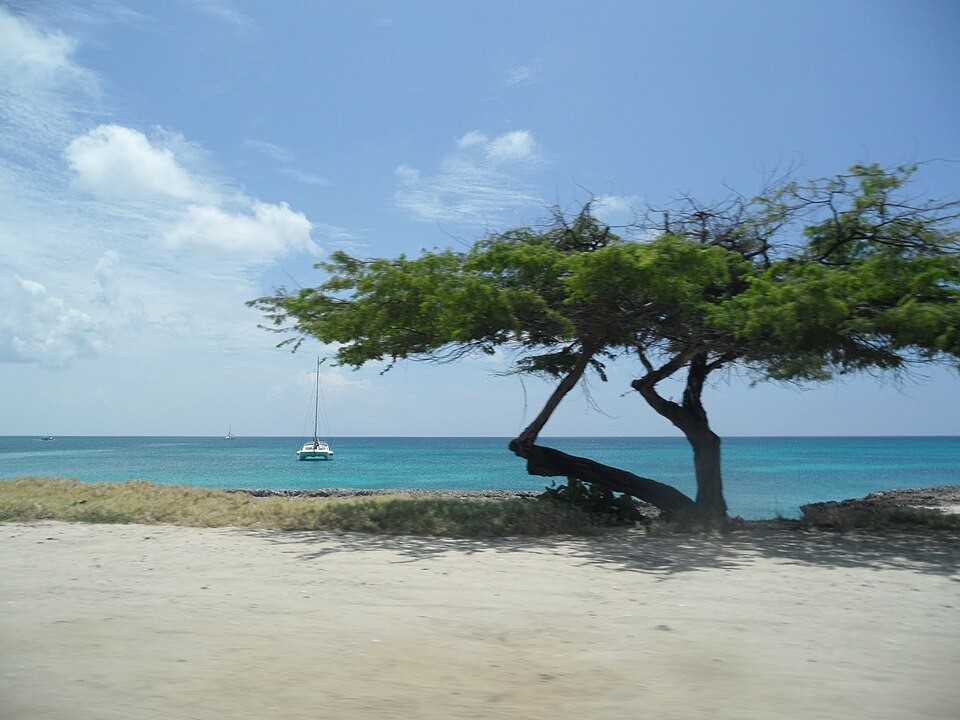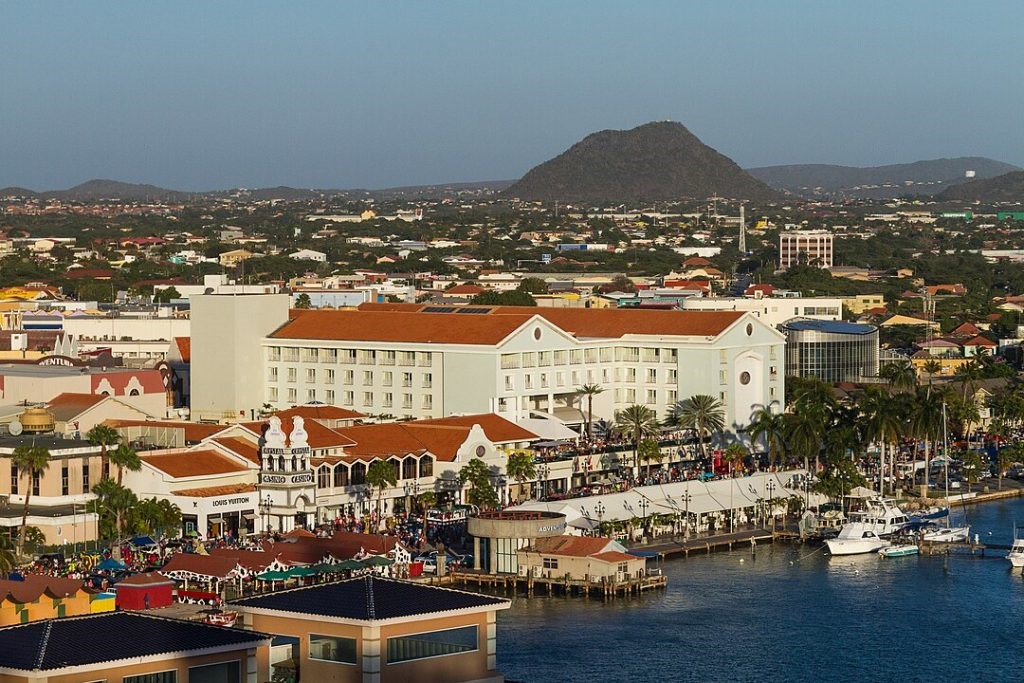Aruba is known for its pristine beaches and turquoise waters.

Oranjestad, Aruba. They speak four languages in Aruba (including an Amerindian Taino/Arawak dialect). That alone makes this island destination interesting. But, for me, the flamingos were hands-down the coolest thing. As soon as I was pretty sure the birds were being treated fairly, I was (somewhat) comfortable with their semi-captivity. Aruba is a ‘constituent country‘ with the Netherlands (since 1986), so they speak Dutch.

By EgorovaSvetlana – Own work, CC BY-SA 4.0, https://commons.wikimedia.org/w/index.php?curid=145173339
Aruba‘s official languages are Dutch and Papiamento. While Dutch is the sole language for all administration and legal matters, Papiamento is the predominant language used on Aruba. Papiamento is a Spanish/Portuguese-based creole language, spoken on Aruba, Bonaire, and Curaçao, that also incorporates words from Dutch and various West African languages. English and Spanish are also spoken, their usage having grown due to tourism.
This island is surprising close to Venezuela–18 miles–and is only 20 miles long. Alongside Bonaire and Curaçao, Aruba forms a group easy to remember as the “ABC islands.” It has a little over 100,000 inhabitants.
In contrast to much of the Caribbean, which experiences humid tropical climates, Aruba has a dry climate with an arid landscape.
Between 1529 when Alonso de Ojeda arrived as the first European, and the signing of the Treaty of Westphalia (1648), the name “Isla de Oruba” was used for the island by the Spanish. After the signing, the island was ceded to the Dutch and gradually its name changed to Aruba. I enjoyed learning about the Treaty as I was an exchange student to Westphalia, now in Germany.

The appropriation of the Caribbean region turned out to be a failure for the Spaniards. The exploitation of the West Indian islands proved unprofitable, and gold mining on Hispaniola (Haiti/Dominican Republic) and Puerto Rico declined. Spanish settlers moved elsewhere, and In 1569, the Spanish Crown banned settlement on the Caribbean islands by Royal decree. This measure that did not apply to the leased islands of Curaçao, Aruba, and Bonaire.
The colonization of the large Caribbean islands, such as Cuba, was encouraged, while the small islands were abandoned. Most of the islands remained largely uncontrolled and undefended, making them a potential opportunity for northwestern European countries that wanted to break Spain‘s monopoly on colonizing the New World. England, France, the Netherlands, and Denmark explored the possibilities of piracy and trade on the Caribbean islands.
The conquistadors brought not only people but also European cattle to Aruba. Over time, they also introduced goats, sheep, dogs, donkeys, cows, pigs, and possibly even cats. It’s believed that rabbits, brought by the Dutch, later became wild on the island. Aruba essentially became a Spanish ranch, with cattle roaming freely in search of food. The horses introduced here were lighter than Dutch ones, and their hooves became so hard from roaming freely that they didn’t need horseshoes.
After hostilities resumed, the Dutch established the West India Company with the main objective of engaging in strategic military actions and privateering organization against Spain. This was the raison d’être of the WIC. Their secondary objective was focused on commerce and colonization, a choice that ultimately led to the downfall of the WIC in 1674. The WIC also gathered information on Spanish treasure fleets.
In 1623, three years after the Pilgrims landed at Plymouth, the first official fleet of the new WIC, a small squadron of only three ships set sail for the Caribbean to engage in looting and plundering in the Lesser Antilles and the Yucátan peninsula. It was during this voyage that the Dutch first encountered Aruba.
Between the Peace of Westphalia in 1648 and the Peace of Nijmegen in 1678, there were 30 years of crisis in the Dutch Antilles and the entire Caribbean region. By 1648, Curaçao had lost its importance as a military outpost. Governor Peter Stuyvesant had a plan to strengthen the connections between the islands and New Netherland (East Coast of the U.S.).
The British Empire took control of the island during the Napoleonic Wars holding it from 1806 to 1816, after which it was returned to Dutch authority in accordance with the Anglo-Dutch Treaty of 1814. Aruba was then integrated into the Colony of Curaçao and Dependencies, along with Bonaire.
During World War II, the Netherlands was occupied by Nazi Germany. In 1940, the oil facilities in Aruba came under the administration of the Dutch government-in-exile in London, causing them to be attacked by the German navy in 1942.
The book Buccaneers of America, first published in 1678, states through eyewitness account that the natives on Aruba spoke Spanish already. Spanish became an important language in the 18th century due to the close economic ties with Spanish colonies in what are now Venezuela and Colombia. Venezuelan TV networks are received on the island, and Aruba also has significant Venezuelan and Colombian communities.
Today, Roman Catholicism is the dominant religion, followed by approximately 75% of the population. In addition to Catholicism, there is a diverse range of religions practiced in Aruba, including Protestantism, Islam, Hinduism, Judaism, and spiritual beliefs of the indigenous people (e.g. African diaspora religions, Santeria).
The island’s economy is dominated by four main industries: tourism, aloe export, petroleum refining, and offshore banking. Aruba has one of the highest standards of living in the Caribbean region. Until the mid-1980s, Aruba’s main industry was oil refining. Then the refinery was shut down and the island’s economy shifted towards tourism.
Currently, Aruba receives about 1.5 million guests per year, of which three-quarters are Americans. Tourism is mainly focused on the beaches and the sea. About 3/4 of Aruba’s modern economy is tourist-based.
Follow Jim Luce on Facebook, Instagram, LinkedIn, TikTok, and X (Twitter).




